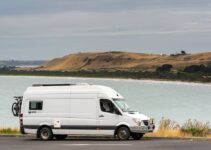Cut to the chase about the best van for camper conversion so you can spend less time shopping and more time planning and building!
Welcome to the first day of the rest of your van life. The moment you start driving home with a hollowed-out cargo van, van life stops becoming a distant dream and starts becoming your reality.
All the time spent thinking about and planning for what living in a van will be like pivots and the rubber literally hits the road once you have the vehicle title in hand.
Chances are, you’ve already done some research. And if you’re like us, you already have a pretty good idea in mind of which van will make for the best van conversion. So we’re not going to be too wishy-washy in this post.
The further down the rabbit hole of determining our favorite cargo van to build out, the more we found we really had to weigh exactly what we thought we wanted with what was actually possible.
And then we met many van dwellers that had completed their own DIY van conversion and some of the things they did completely blew our minds about what was possible with the right van!
The wrong van can quickly turn that dream into a nightmare, so tread carefully. The van you choose will be your bedroom, bathroom, kitchen, living room, office, and front porch, all strapped to a powerful engine and hurling down the highway. And that’s before you consider all the van essentials and personal items you’ll pack inside.
Your camper conversion is a lot like a blank canvas, only it costs upwards of $30,000 or more. With that kind of investment necessary, you should expect a complete package.
Vans on our list had to pack an engine that can handle mountains, rivers and winding coastal roads, plenty of interior space for customization, and a drivetrain/wheelbase that gets you through bumpy forest pathways to find that perfect freedom camping spot.
Finding a van that has all three of these things crosses loads of pretenders off the list and leaves only a few contenders to fight for the title of the best van for a camper conversion.
This buying guide will walk through the ins and outs of the world’s best cargo vans so you can decide which shell is best for your van life. In fact, most van conversions these days are one of the following top brands, which we’ll cover in much more detail below:
(Note: We have no affiliate relationship to any of these companies, but instead are linking to each make and model’s official sales page.)
- Nissan NV
- Chevy Express Cargo Van
- Ford E-Series Cargo Van
You’ll find industry favorites and a few surprises covered here, but rest assured that your dream van is somewhere on this list, so read along and start your to-do list.
Base Cost | Fuel Type | Roof Height | Wheelbase | Conversion Length | |
Mercedes Sprinter | $41,000+ | Diesel | 76.7" - 79.1" | 144" - 170" | 132" - 189" |
Ford Transit | $36,000+ | Gasoline | 56.9" - 81.5" | 130" - 148" | 115" - 162" |
Dodge Ram Promaster | $34,000+ | Gasoline | 66.3" - 77.1" | 118" - 159" | 106" - 160" |
Nissan NV | $30,000+ | Gasoline | 55.8" - 76.9" | 146.1" | 120" |
Chevy Express | $33,000+ | Gasoline | 52.9" - 53.4" | 135" - 155" | 126" - 173" |
Ford E-Series | Varies (only used models) | Gasoline | 53.9" - 54.2" | 138" | 121" - 142" |
Questions to ask yourself when determining the best van for camper conversion.
We’ll cover these in more detail after we walk you through each of the 6 best vans for camper conversion. But essentially you need to ask yourself these questions before you commit to one van or another.
With some of the answers, such as offroad capability, your choice of vans won’t matter too much. But when it comes to height, engine and living space you’ll find one van may stand out more than other cargo vans.
When deciding the best vans to put on our shortlist we were hyper-critical of our answers to the following questions:
- Height: How tall are you? And does it matter to you whether you can’t stand upright?
- Wheelbase: How much interior room do you want?
- Fuel: What kind of fuel/engine do you prefer?
- Offroad: Do you plan to spend time off the beaten path? Is 4wd essential to your travel plans?
- Weight and Wheels: Do you want a dually to hold more weight?
- Hobbies: How will you use your van (bike, surf, snowboard, climb, work, etc.)
- Human Capacity: How many people will be living in it?
The 6 Best Van for Camper Conversion Options
Evaluating the best vans for a DIY camper conversion came down to the following 6 most popular makes and models. You can get creative with other cargo vans.
But these are pretty much the only ones you need to consider for a van conversion in 2022.
Mercedes Sprinter
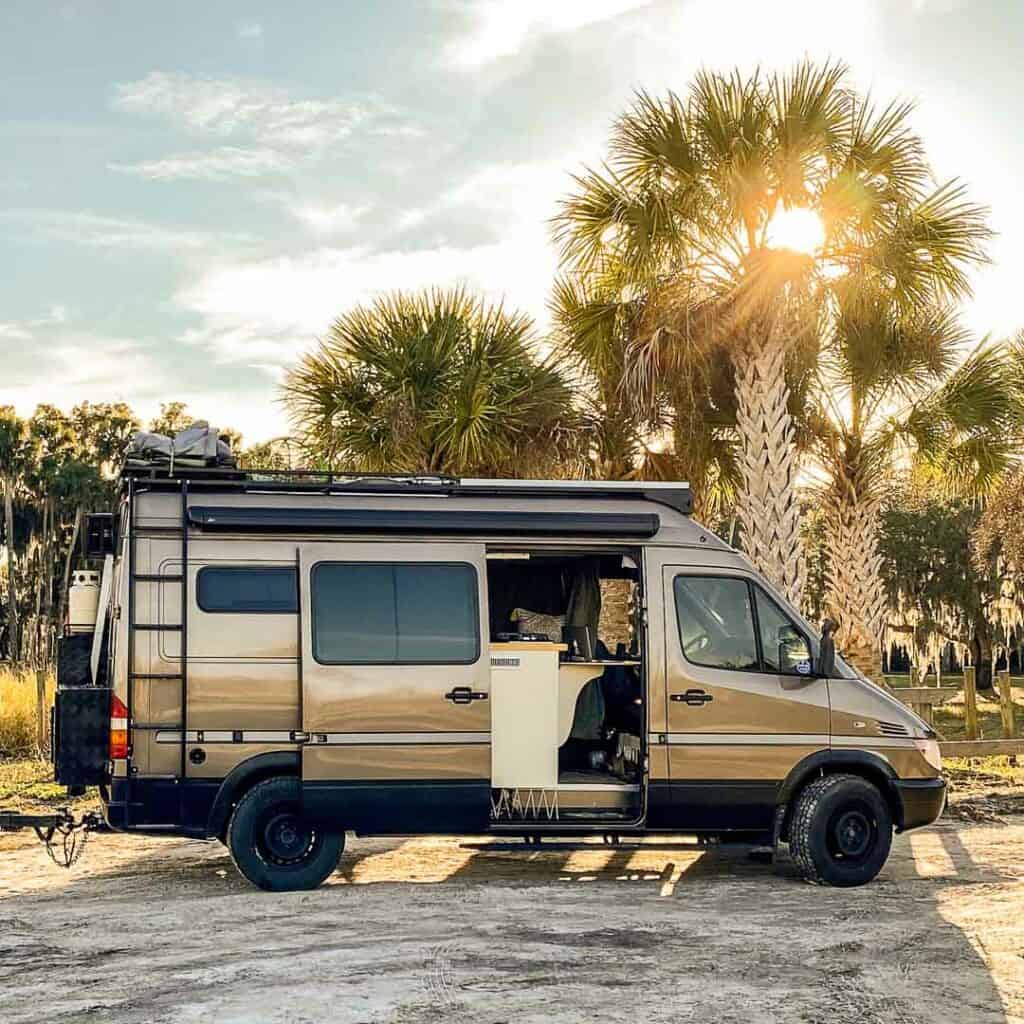
If you ever find a list of the best vans for camper conversions without this legend at the top, ignore it. The Mercedes Sprinter van has set the standard for camper van conversions, and all other companies are simply trying to keep up.
Because they are the original cargo van conversion, Mercedes Sprinters are numerous on the road and picking up a decent deal on older used models is not unheard of. Newer models require DEF fluid as part of the deal. But older models manufactured before 2007 do not require DEF fluid.
From cargo space to resale value, you won’t find a more fuel-efficient and popular van capable of supporting a full-time van life than the Mercedes Sprinter.
The only catch is that these beauties won’t come cheap. With a starting price of over $40,000 for a new cargo van you are looking at an overall higher cost of ownership than with other van options.
Entirely built-out Mercedes Benz sprinter vans equipped with four-wheel drive are routinely listed for up to $100,000. But many campers just can’t resist a Sprinter van conversion that is already built for the road.
Mercedes sprinter’s main draw is the high-end technology implemented throughout. No matter what length, wheelbase or interior height you’re looking for, you can bet you’ll find a unique Mercedes Sprinter suitable for you and powered by a high-quality diesel engine.
NEED INSPIRATION? Check out Anthony and Sharon’s awesome Mercedes Sprinter campervan build!
These engines can last hundreds of thousands of miles longer than a gas engine, sharply increasing resale value.
The main drawbacks to these pristine machines are finding parts and repair services for such complicated engines.
Mercedes sprinter vans often require specialists for engine repairs, and the complex electrical wirings won’t make your van conversion process a simple task. Maintenance costs can add up quickly and be a deterrent if you’re looking at the total cost of van life.
Here’s the bottom line: These vans are the best. But they are also the least affordable van style.
PROS
- The diesel engine will last a long time
- Built with the best available technology
- Loads of customization and shape options
- Have 4×4 option
- Tons of room for living space (most of all options)
CONS
- Most expensive van
- Can be difficult to find qualified mechanics and parts for repairs
- Expensive parts and maintenance
- Newer models require DEF fluid
READ NEXT: If you’re considering a Sprinter, check out our post on why we think the Mercedes Sprinter for van life may be the best van for your van lifestyle!
Ford Transit
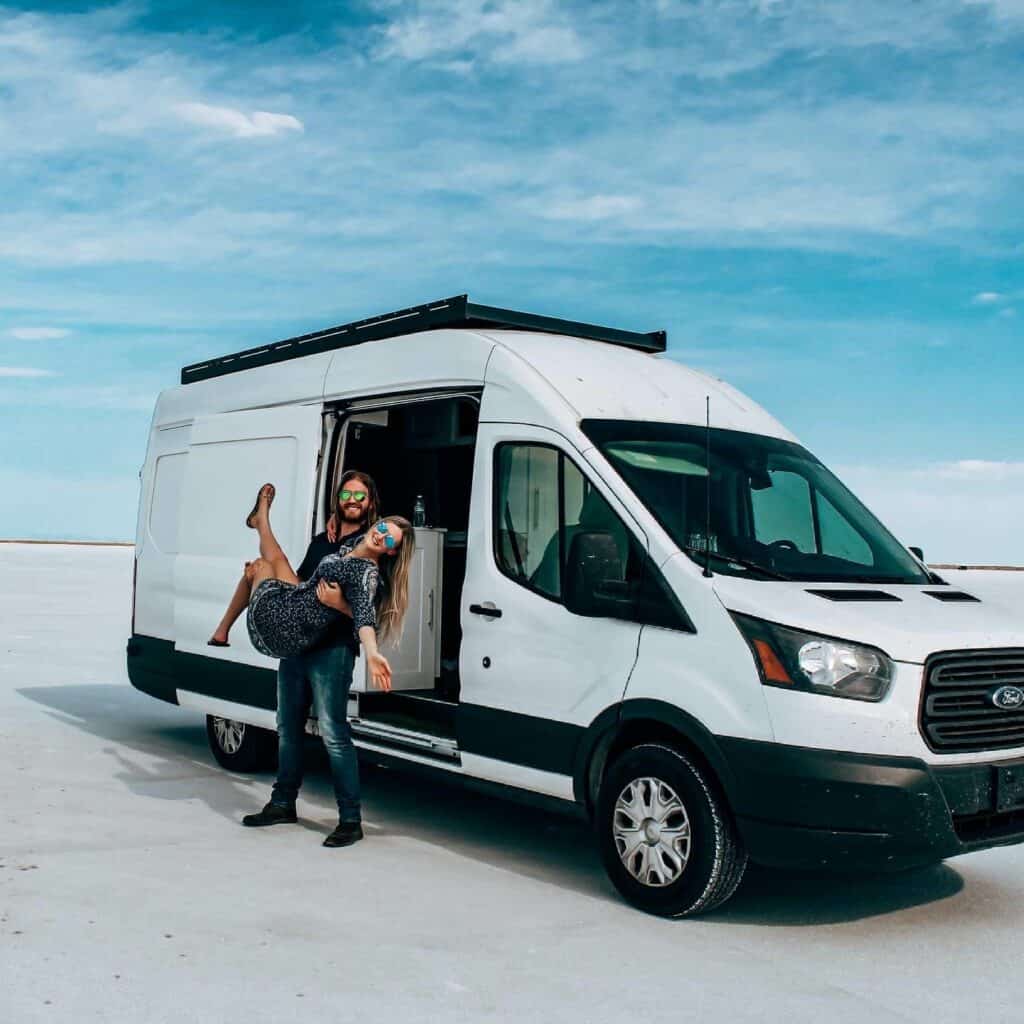
A much more middle-class option, with a starting price of around $34,000, this American-made conversion van looks and feels a lot like Mercedes Sprinters with much less complicated bits and pieces.
Not only is the starting cost for a Ford Transit lower, but you’ll also save a few bucks on the maintenance costs and still have plenty of room for living while enjoying cross-country road trips.
The Ford Transit is one of the most famous American cargo vans on the market. This means even if you’re van breaks down in the middle of nowhere you won’t be too far from parts.
You can also convert the Ford Transit into a 4×4 and newer models come with an all-wheel-drive as a standard option. And if roof height is a top priority, the Ford Transit offers the highest standard roof height in their high roof models.
NEED INSPIRATION? Check out Lauren’s incredible Ford Transit campervan build!
So why doesn’t everyone love Ford Transit the same way they swear by a Sprinter van? A Ford Transit is a much more barebones product that doesn’t offer the same longevity as other options. So keep that in mind if you’re looking for a DIY camper conversion for life.
The Ford Transit hasn’t been around for decades, so we can’t say for sure how long it’ll last. But you should anticipate replacing either the engine or the transmission within the 200,000-mile marker.
While Ford Transit can’t confirm how they will stand the test of time like other models if van living isn’t in your long-term plans, these humble units are some of the best vans to renovate into a mobile living space at an affordable price.
PROS
- Lots of qualified mechanics everywhere you travel
- Relatively affordable high-roof van
- Loads of customizable options
- All-wheel-drive makes it great for offroad
- Higher roof than other options
CONS
- Barebones driving quarters
- Brakes have been known to not last long
- Relatively new model with not many used options
READ NEXT: If you’re thinking about a Ford Transit, check out our post on why we think a Ford Transit for van life may be the best van for your van lifestyle!
Ram Promaster
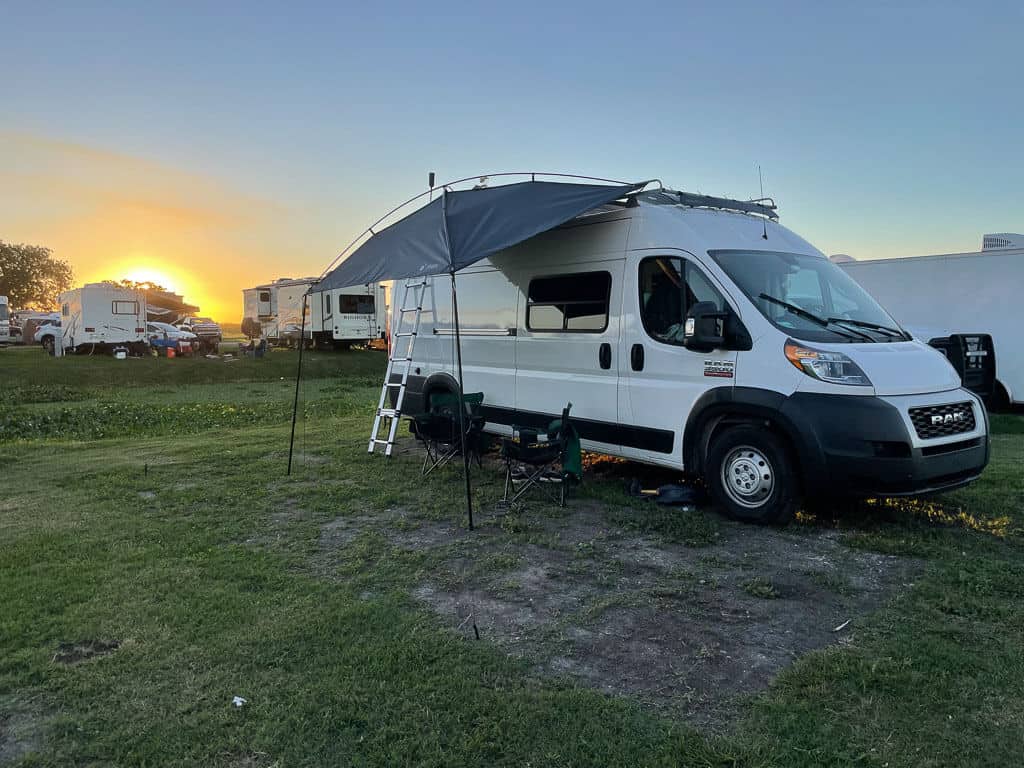
Starting at around $34,000, the final contender of the big three, the Ram Promaster van is another more affordable cargo van that doesn’t quite pack in the adventure features as the other two leading players but has a few of its own perks.
For starters, this cargo van is the widest van on our list. The difference isn’t much, but you’ll be surprised at how much difference a few precious inches makes when mapping out your interior.
And while the roof height isn’t necessarily worth writing home about, with the additional few inches in width, you can build a bed that allows you to sleep east-west rather than north-south. This will give you loads more interior space for your van conversion.
NEED INSPIRATION? Check out Lita and Dylan’s beautiful Dodge Pro Master campervan build!
The Ram Promaster is also a boxier van option, with more square than rounded interiors. This helps when it comes to building out the inside of your van. Round spaces mean you have to either build wonky to maximize the space or trim the round sides from your build and effectively decrease the overall living space.
This width makes the Ram Promaster a contender. But the style has serious limitations. You won’t find a 4X4 option, an instant disqualifier for some adventures.
There also are no basic trim models of these conversion vans that come without low ground clearance. Basically, these vans are not built for off-roading.
They are constantly on the more affordable end of the camper van spectrum, and they’ve been around for a while, meaning you can find plenty of used Ram Promaster vans to convert.
PROS
- Widest van on our list (extra 6″)
- Front-wheel drive
- Can be found for the cheapest of the big 3 options
- High-end driving features at a budget cost
- Square or “boxier” shape for building
CONS
- No 4×4 options
- Lowest ground clearance of the 3 main van models
Nissan NV
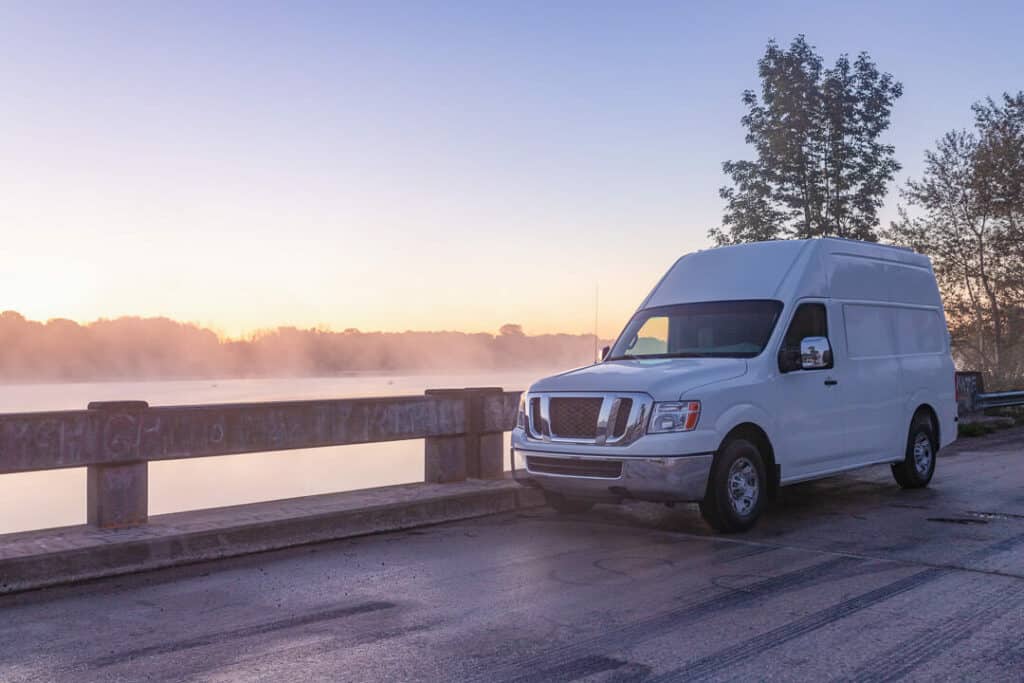
As van life becomes more accessible, stealth camping is harder and harder to come by. Nobody is getting fooled by a Sprinter van with a fan or AC unit anymore. So if you’re looking for vans to convert that will fit in almost anywhere, you’ll have to get a bit more creative to sleep on the city streets.
Enter the Nissan NV. These unassuming cargo vans are some of the smallest passenger vans on the market that still come with standing room and maybe the most stealthy camper van out there.
No one expects these lowkey models to double as mobile homes. And with the proper conversion, you can turn this slim rear cargo area into a cozy cottage on the go.
The smaller size makes the Nissan NV affordable across the board. With a grand entry price of around $30,000, fewer conversion costs, and a decent gas mileage your total cost of ownership is likely to be significantly lower than with other conversion vans.
Nissan themselves haven’t even realized the potential of their small high-roof models, which means you won’t find a stock option with 4×4. But you can do an aftermarket 4×4 conversion and lift to eliminate the low ground clearance issue and make this one of the best vans for offroad adventures.
This van is a true contractor special. And while it’s not a very roomy option, it’s the right van for stealthy van life, especially if you plan to travel by yourself.
PROS
- Best stealth camper conversion on the market
- One of the cheapest new van conversion options
- Smallest van you can still stand up inside
- Best commercial van warranty at 5 years/100,000 miles
CONS
- No 4×4 stock options
- A bit too small to live comfortably
- Only available in rear-wheel drive
- Not many used options are available
Chevy Express
Are you looking for a low-roof crew van? Look no further. The Chevy express cargo van is as simple as they come, making the model ripe for a quick camper van conversion.
A stock Chevy Express passenger van comes with a durable chassis, and a few good looks at the used models shows this van expects to last a few decades. Starting around $33,000, these are decent vans to convert.
While we can’t endorse full-time living in a van that you’ll have difficulty standing up inside of, there is plenty to love about these unassuming work trucks that are easy to repair. You can even add on your own high roof, although it won’t be an easy (or cheap!) task.
The lack of interior length and height options means the Chevy Express isn’t for everyone. But it doesn’t get easier to build or maintain than this low-profile reliable model.
PROS
- Nobody will suspect you’re living out of such a small van
- You can find incredibly affordable used models
- Easy to renovate, repair and upgrade
CONS
- No high roof options
- It’s the stereotypical “creepy white van” model associated with the negative side of van life
- No 4WD options
Ford E-Series
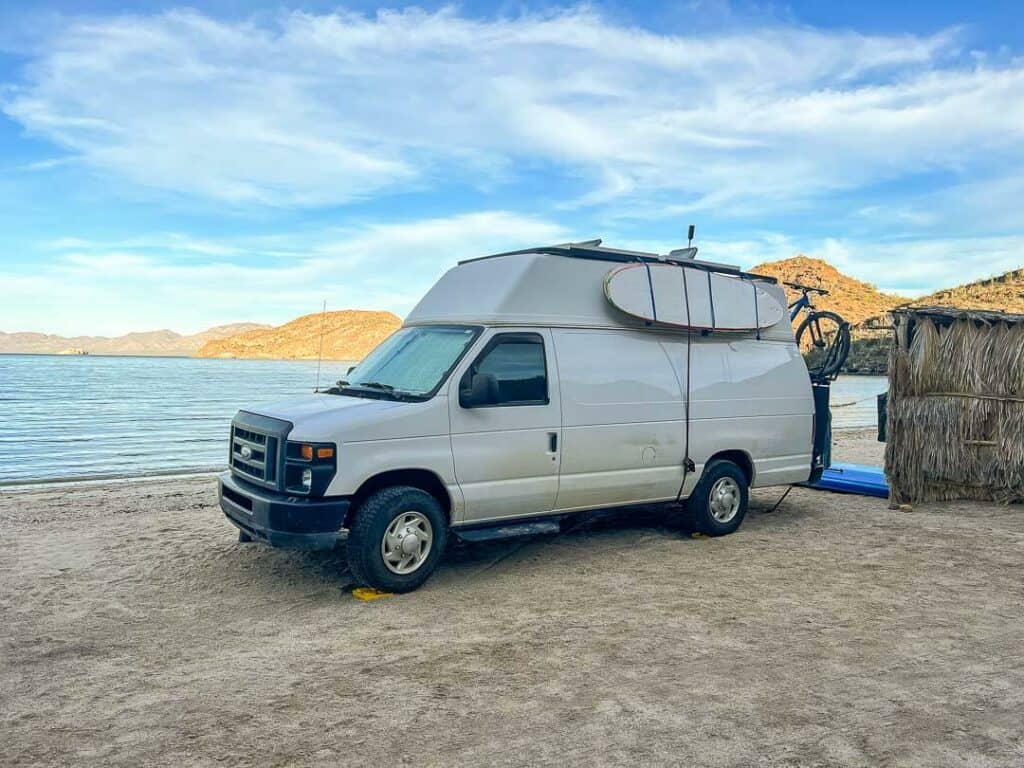
New Ford E-series models are nothing more than an engine, crew cab, and an empty chassis for van conversions who really want a blank space. After serving as Ford’s dependable work truck line for decades, the model was recently replaced in 2014 by the Ford Transit van.
While there aren’t many new Econoline vans out there, you’ll find a thriving used van market for these affordable vehicles. RV companies across the board have teamed up with Ford to turn the E-series into Class B and Class C RVs with all the bells and whistles.
NEED INSPIRATION? Check out Bobby and Mary’s creative Ford E350 Hight Top Roof campervan build!
The dependable engine and transmissions on these engines may need some TLC. But a used E-series van may be the most affordable conversion option out there, as long as you know you’re way around an old engine.
After buying one of these old vans, the first thing you should do is replace the brakes, as they are notorious for giving out after a few thousand miles.
Companies simply don’t make vans like this one anymore. You can easily find an E-series van with a pull-out bed above the drives cab, which revolutionizes the interior space (and makes the van get less than 10 miles to the gallon!)
PROS
- Widely available
- Affordable
- Loads of conversion and kits options
- Thriving used van market
- Most affordable engine repairs and maintenance
CONS
- Typically high mileage
- Only used options available
- Only one wheelbase option
- New E-series vans don’t have much of a body and are not meant for average van life
What to Look for When Choosing a Van for Conversion
Some of these vans may look the same, but no two models are identical. Everyone has a favorite pick for the best van for camper conversion based on their own specific wants and needs.
So consider each of these factors before deciding on the best model for your transformation.
READ NEXT: If you think you want to convert your own van, be sure to check out our guide for building a campervan!
Roof Height
One thing that will instantly add $10,000 to the value of a conversion van is the standing room. Nomads of all shapes and sizes swear by one simple truth. If you want to live in a van full-time, you need to stand up inside fully. So high-roof vans almost always prevail over their low-roof counterparts.
The most significant exception to this rule is if stealth is your number one concern. It’s hard enough to sneak a chevy express in a high-profile neighborhood. And it’s about impossible to pretend you aren’t living inside a Sprinter van these days.
The best vans on our list have roof heights that can reach up to 71 inches. But anyone 6′ or shorter can comfortably stand in any of the big three.
A part-time converter can save beaucoup bucks by opting for a van with a standard low roof. But if you’re planning on moving into your rig, your back won’t be happy in there forever.
Best van based on roof height: Ford Transit High Roof
Fuel and Engine Type
You’ll have to decide between diesel and gasoline to power your adventure. There isn’t a massive difference in performance between the two, but there is a significant difference in longevity.
Besides the Mercedes Sprinter, every van on our list runs on gasoline. And these gasoline engines will struggle to reach 250,000 miles. Mercedes vans powered by diesel fuel will blow that number out of the water, albeit at a much higher upfront cost.
But diesel maintenance costs are typically quite a bit higher than their gasoline engine counterparts. Not only will you need to find a specialized mechanic, but also it may be difficult to find various parts you may need.
Also, consider where you plan to travel and how readily available fuel and additives may be. While the Mercedes Sprinter option seems great, a trip on the Pan American highway may be more challenging when you have to put higher quality fuel in the van and also add DEF fluid.
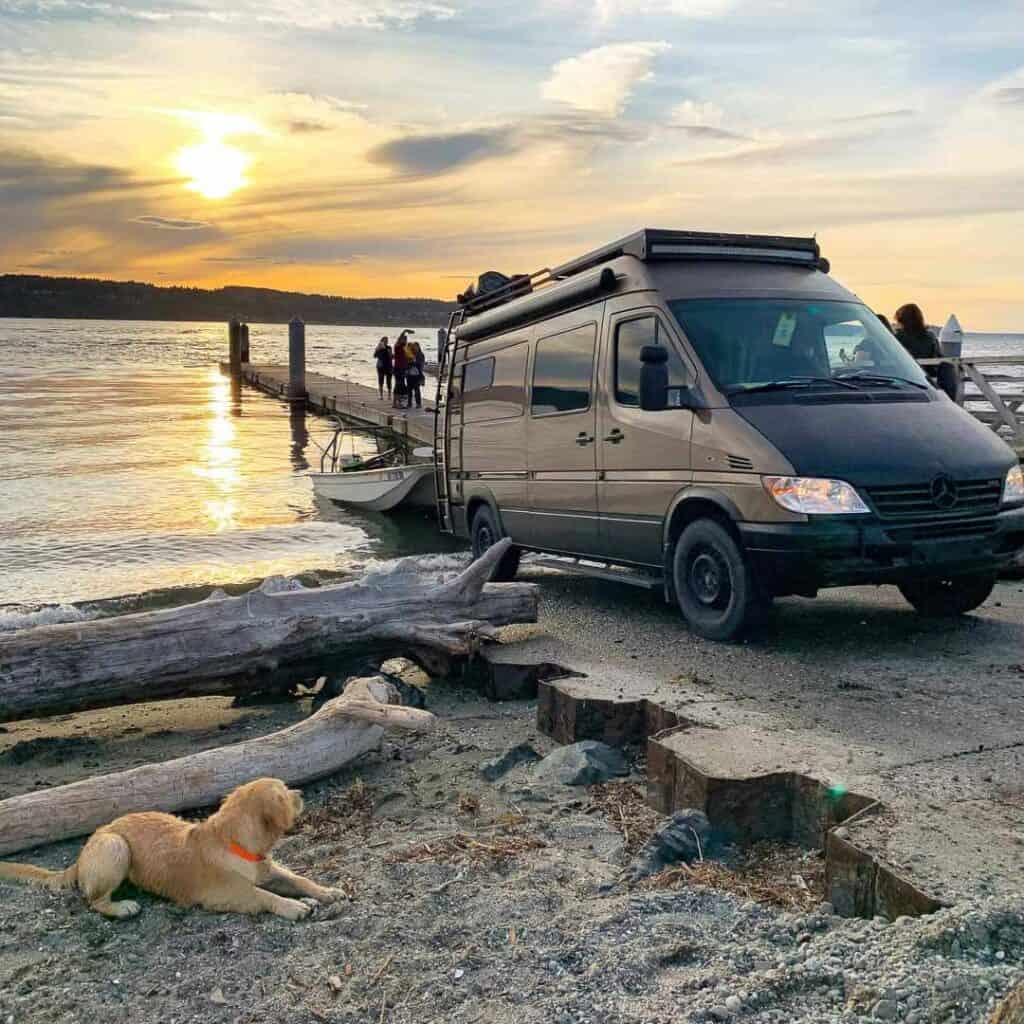
Best van based on engine and fuel type: Sprinter (the only option for diesel), all other vans have gasoline engines.
Wheelbase
The wheelbase of your van is a significant number to pay attention to as it dictates how much interior space you’ll have.
Wheelbase refers to the distance between the front and rear axles of a vehicle and is an excellent indicator of your van’s overall length. Most of the vans on our list have several different wheelbase options. The longer your wheelbase, the more room you have, but the less agility you’ll feel.
When it comes to taking turns, longer wheelbases will need more room to negotiate the turn. So beware of the degree of difficulty a long wheelbase may add to a U-turn. Also, long-wheelbase models are also more challenging to take off-road as you may have difficulty navigating up and down rocky terrain or driving where there are dips in the road.
Vans on our list generally range from 140″ to 171″, and we recommend choosing something on the longer end of the scale from a full-time van life perspective. You’ll appreciate the additional living space and learn to live with the downsides of a longer wheelbase.
Best van with long wheelbase: Mercedes Sprinter
2WD Vs. 4WD
It’s only a matter of time before having 4WD come in handy. But unfortunately, the feature will not come cheap.
We look at four-wheel drive kind of like leveling up in an old-school video game. 4WD instantly gives you access to various roads and landscapes off-limits to 2WD, which typically only provides gas to the rear wheels.
But unlike leveling up in a video game, it will cost you to either buy a new van with a 4×4 option or to add an aftermarket 4-wheel drive kit to your van.
The lack of 4WD is the biggest knock against the Ram Promaster. And on the other hand, Mercedes 4WD Sprinters are one of the most valuable vans on the market.
That is because if you ask any van lifer, many of the most fantastic campsites they’ve ever slept in have been at the end of some pretty gnarly roads.
If you’re shopping for a van for a cheap way to live in the city or traveling where you’ll stay mostly on paved roads then you can get by without 4WD. But anyone looking to get deep into forest service roads should commit to the extra upfront investment.
Best van with 4WD option: Mercedes Sprinter or Ford Transit
Price
Ultimately, for most of us in van life, the decision to buy a van may all come down to the costs. A Sprinter van conversion will require a heavier upfront investment than anything else on our list, and every repair will cost more. And yet, it’s the most popular option on the market because the van’s longevity can save you money in the long run.
The van life is only cheap until you get started. After a few trips to home depot, your budget will quickly get smashed, and surprise costs will soon add up. However, as we’ve shown on this list, several affordable van conversion options will help save a few bucks.
The best way to save money is to buy used ones. While Sprinters can hold their value well past 100,000 miles, you can find secondhand vans with much more high-end features for the same price as a stock new cargo van.
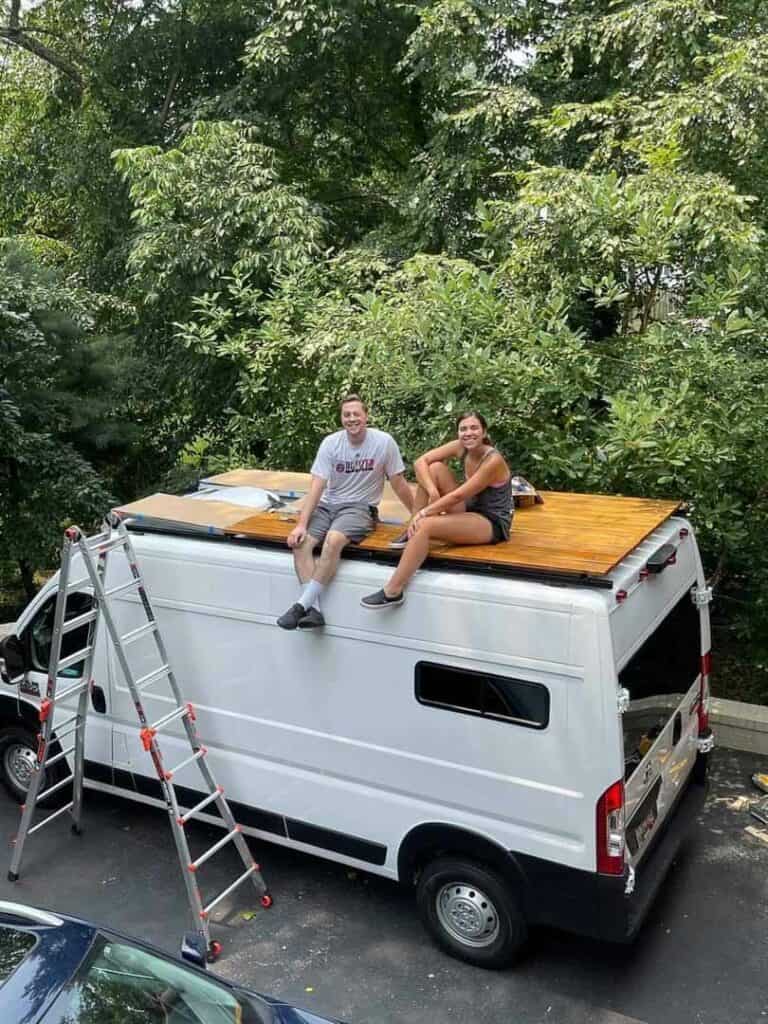
Most affordable van: Nissan NV
Van Conversions FAQ
Although we touched on most of this information already, these are some of the most frequently asked questions when it comes to doing a camper van conversion.
Should I buy a used passenger van for my van conversion?
When it comes to buying a campervan, we believe that used vans will often have better overall value than a new van. Just because a van rolls off the manufacturer’s floor does not mean that it will not break. In fact, you’ll find that the road tends to break many things and sometimes it is better to have a used van that has already been literally broken in.
However, there are comforts that come with the expense of a new van. You’ll likely have some kind of warranty to protect against defective parts. And you’ll know every mile that your van has ever driven.
But when it comes to a used van, you don’t have to worry about scratches and dents or drilling holes in the roof to add solar. You’ll also find a wide range of available vehicles to choose from, particularly with Mercedes Sprinters that have been around for years.
Of course, buying a used van also comes with many challenges. There is uncertainty in what previous owners may or may not have done to maintain it. And many vans need routine repairs and maintenance that could be costly upfront (just adding brakes and new tires could set you back a few thousand dollars!).
But we believe that the best overall value for a DIY camper van conversion is, in fact, a used van. But there is a whole other checklist you should follow before you commit to purchasing a used van.
How much does it cost to convert a van into an RV?
The cost of a camper van conversion will vary due to a large number of factors. From which appliances you want to install to the brand names and quality of those appliances, costs can skyrocket immediately.
Then think about which building materials you plan to use and whether you want to spend more money on more eco-friendly materials that may be less toxic.
Will you go with cheap foam insulation or higher-end wool insulation? Will you add a robust battery bank, inverter and solar panel setup or just scrape by with the minimum?
We’ve interviewed dozens of DIY van lifers who have shared a wide range of costs. And most would value their overall build cost between $20,000-$30,000 in addition to the cost of the van.
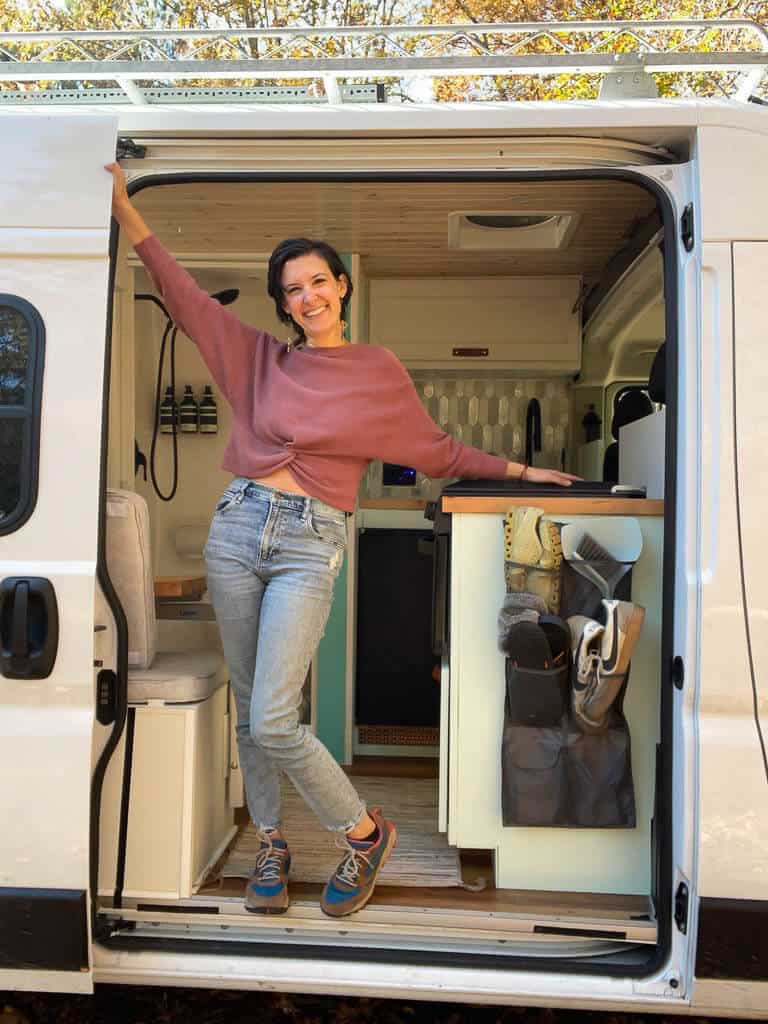
Do I have to register my van conversion as an RV?
Technically you do not HAVE to register your van conversion as an RV. And depending on in which state you register your vehicle, it can be challenging to do so. But there are great benefits to registering your van as an RV.
The biggest benefit is that you will find your insurance rates are significantly lower as an RV than a van. This is because most RV owners do not drive their RV nearly as much as a standard vehicle. Insurance companies offer great deals for vans registered as RVs.
But do be sure that you explicitly communicate with your insurer if you plan to live in your van full-time as different rates and coverages may be available for only part-time use.
We have always stated to our insurance company that we live full-time in our RV and have still had incredibly reasonable RV insurance.
In addition to the reduced cost of insurance, your vehicle registration renewals may also be significantly less. Since vehicle registration is done on a state-by-state basis it is best to check with your state for both the requirements in registering as an RV as well as the benefits.
Which camper van is best to drive On Multi-Country Adventures?
We saved this question for last because it is the criteria by which we are researching and shopping for our own camper van build. With aspirations to drive the entire length of the Pan Am from Alaska to Argentina, we have and continue to, weigh all of the options.
And while we are undecided at the time being, we’ll share some additional criteria to consider:
- Wheelbase: Roads in small towns and villages tend to be narrow so a smaller wheelbase offers an advantage in a smaller turn radius. But longer wheelbases allow for more living space, which would be nice with a multi-year journey
- 4×4 Capability: 4-wheel drive is not necessary to travel the full length of the Pan American Highway. But having 4wd not only eases our minds in questionable situations but also allows for more exploring along the way.
- Roof Height: At 6’4″ (76 inches) tall, it would be nice to have a high roof van with the highest dimensions possible for day-to-day living arrangements. But once you reach Panama you must ship your van to Colombia across the Darien Gap and tall roof vans likely will not fit into a container. This will require you to ship roll-on roll-off, which means handing the keys to your home to a stranger who can access (and take) anything out of the van and living space.
- Fuel and Engine Type: Both gasoline and diesel fuel are readily available throughout North, Central and South America. But when it comes to routine maintenance, having a simple gasoline engine that is not only easy to find mechanics to work on but also has affordable and easily accessible parts is a bonus.
- Price: Although we have learned to look at the best overall value for the long term, it is hard to swallow the idea of shelling out big bucks upfront before even starting the build. But it is important to factor in future maintenance and repairs and we are more inclined to look for a used cargo van instead of a new one to save upfront costs.
At the time of writing, we are personally leaning heavily toward the Ford Transit. With a long wheelbase, most headroom, all-wheel-drive capability and a common gasoline engine this option makes the most sense for what we could see spending 18 – 24 months living in throughout the Pan American Highway.
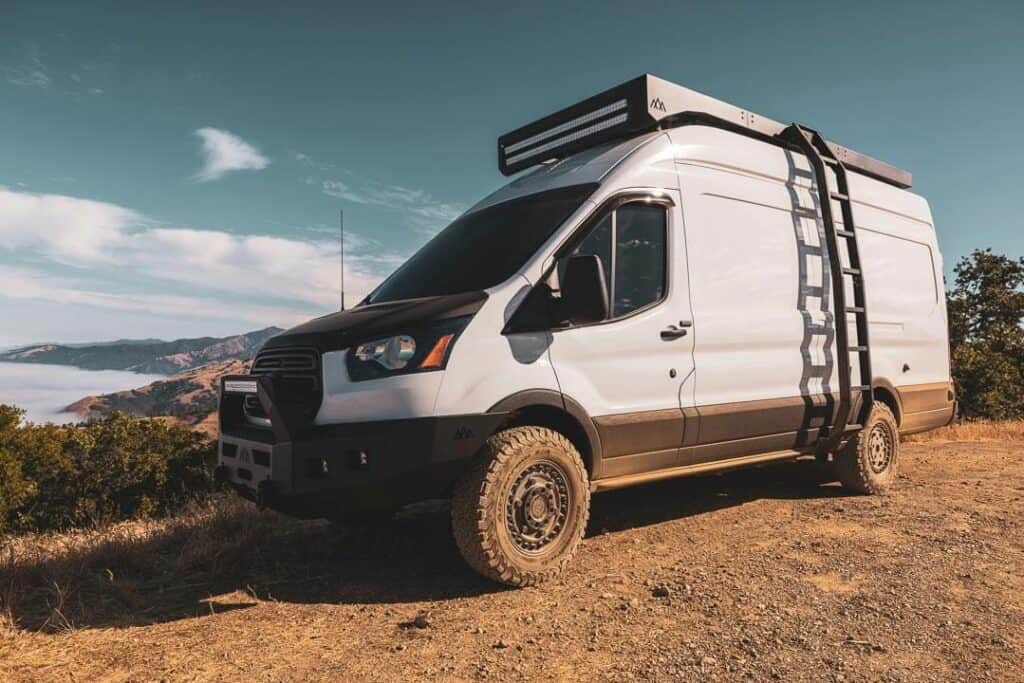
Wrapping Up
There are lots of things to consider when deciding which is the best van for camper conversion. Between the upfront cost of each van and the additional features such as wheelbase, roof height, engine type and 4WD capability the options are virtually endless.
But there are only 6 main cargo or passenger van types that most van lifers look to convert. Of those 6, three stand out as the most common and most desirable: Mercedes Sprinter, Dodge Ram Promaster and Ford Transit.
Which one you choose ultimately comes down to personal preferences as you evaluate the criteria most important to you. Let us know which one you think is best, or which one you chose for your van conversion, and why you think it is the best!


